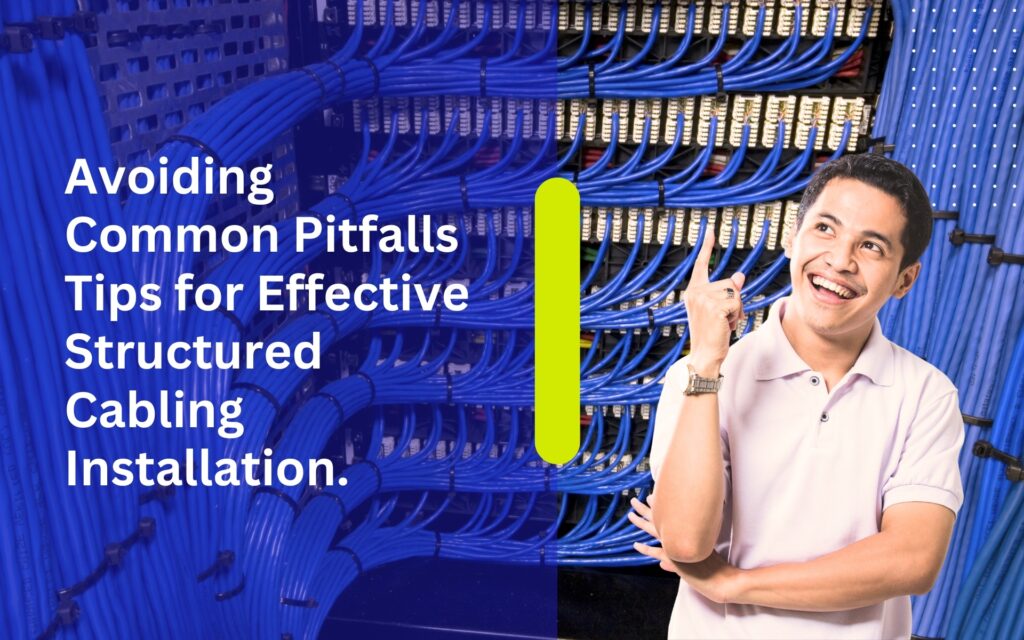The On-the-Job Training Experience of Gester Samson. Introduction. The On-the-Job Training journey marks a crucial stage for students as they step into real work environments and apply what they have learned in …
Avoiding Common Pitfalls: Tips for Effective Structured Cabling Installation.

Introduction
In the digital age, where connectivity is the backbone of every business operation, the importance of structured cabling cannot be overstated. Properly installed cabling infrastructure forms the foundation upon which efficient communication networks thrive. However, the process of structured cabling installation can be intricate and fraught with challenges. From planning and design to implementation and maintenance, each stage demands meticulous attention to detail to avoid common pitfalls that can undermine performance and reliability. This article serves as a comprehensive guide, offering insights and strategies to steer clear of these pitfalls and ensure the successful deployment of structured cabling systems.
Understanding Structured Cabling
Structured cabling is the standardized and organized approach to network infrastructure, encompassing the design and installation of cabling systems to support various communication technologies within a building or campus environment. Unlike traditional point-to-point wiring, structured cabling provides a cohesive framework that accommodates current and future needs, facilitating scalability, flexibility, and ease of management.
Common Pitfalls to Avoid
1. Inadequate Planning and Design
One of the cardinal sins in structured cabling installation is rushing into the process without comprehensive planning and design. Failure to conduct a thorough assessment of current and future requirements can result in haphazard installations that are ill-suited for the organization’s needs. To avoid this pitfall, invest adequate time and resources in planning, considering factors such as anticipated growth, technology advancements, and building layout.
2. Neglecting Cable Management
Effective cable management is essential for maintaining a tidy and efficient cabling infrastructure. Neglecting this aspect can lead to a tangled mess of wires, hindering troubleshooting efforts and impeding airflow, which may result in overheating. Employ cable trays, racks, and labels to organize cables systematically, ensuring ease of access and maintenance.
3. Ignoring Standards and Regulations
Structured cabling follows industry standards and regulations to ensure interoperability, reliability, and safety. Ignoring these standards can compromise the integrity of the network and may even violate building codes. Familiarize yourself with relevant standards such as TIA/EIA-568 and ISO/IEC 11801, and adhere to them meticulously throughout the installation process.
4. Poor Cable Management Practices
Improper handling of cables during installation can lead to signal degradation, interference, and even physical damage. Avoid sharp bends, excessive pulling, and over-tightening of cable ties, as these can weaken the cables and impair performance. Additionally, maintain proper separation between power and data cables to minimize electromagnetic interference (EMI).
5. Underestimating Future Needs
Scalability is a key consideration in structured cabling installation, as businesses evolve and technology advances. Underestimating future needs can result in costly retrofitting or, worse, necessitate a complete overhaul of the cabling infrastructure. To mitigate this risk, incorporate provisions for expansion and upgrades into the initial design, such as installing additional conduits and leaving spare capacity in patch panels.
Tips for Effective Structured Cabling Installation
1. Conduct a Site Survey
Before embarking on the installation, conduct a thorough site survey to assess the existing infrastructure, identify potential obstacles, and determine the optimal placement of equipment and cables. This proactive approach minimizes surprises during installation and ensures a smoother deployment process.
2. Invest in Quality Components
The reliability and performance of a structured cabling system are heavily reliant on the quality of its components. Invest in high-quality cables, connectors, patch panels, and other accessories from reputable manufacturers to minimize the risk of premature failure and ensure long-term performance.
3. Follow Best Practices
Adhere to industry best practices throughout the installation process, from cable routing and termination to testing and documentation. Consult manufacturer guidelines and certified installers for guidance on proper techniques and procedures, and avoid taking shortcuts that may compromise the integrity of the installation.
4. Document Everything
Comprehensive documentation is crucial for effective troubleshooting, maintenance, and future upgrades. Document the cabling layout, labeling scheme, test results, and any deviations from the original design to provide a roadmap for ongoing management and support.
5. Conduct Thorough Testing
Before commissioning the cabling infrastructure, conduct comprehensive testing to verify compliance with performance specifications and identify any potential issues. Utilize specialized testing equipment such as cable certifiers and network analyzers to assess signal integrity, attenuation, and crosstalk, ensuring that the installation meets or exceeds industry standards.
Conclusion
Structured cabling installation is a complex undertaking that requires careful planning, meticulous execution, and adherence to best practices. By avoiding common pitfalls and following the tips outlined in this article, organizations can ensure the successful deployment of reliable and scalable cabling infrastructure to support their evolving communication needs. Remember, the foundation of a robust network begins with structured cabling, so invest the time and resources necessary to get it right from the outset.
Related Articles
The On-the-Job Training Experience of Francis Daniel Austria. Introduction On-the-Job Training serves as a transformative phase for students as they transition from academic learning to real-world environments. For Francis Daniel Austria, the …
The On-the-Job Training Experience of Carl David Buena. Introduction On-the-Job Training plays a vital role in shaping the professional skills and work ethic of students as they transition from academic learning to …
